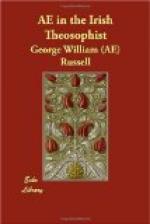A Reverend and learned professor in Trinity College, Dublin, a cynic and a humorist, is reported once to have wondered “why the old Irish, having a good religion of their own, did not stick to it?” Living in the “Celtic twilight,” and striving to pierce backward into the dawn, reading romance, tradition and history, I have endeavoured to solve something of the mystery of the vast “Celtic phantasmagoria,” I can but echoe the professor. In these legends, prodical of enchantment, where Gods, heroes and bright supernatural beings mingle, are at league or war together, I have found not misty but clear traces of that old wisdom-religion once universal. There are indeed no ancient Irish Scriptures I am aware of, but they were not needed. To those who read in the Book of Life, philosophy and scripture are but as blinds over the spiritual vision. But we today— lost children of the stars—but painfully and indirectly catch glimpses of the bright spheres once our habitations, where we freely came and went. So I will try to tell over again some of these old stories in the light of philosophy spoken later. What was this old wisdom-religion? It was the belief that life is one; that nature is not dead but living; the surface but a veil tremulous with light—lifting that veil hero and sage of old time went outwards into the vast and looked on the original. All that they beheld they once were, and it was again their heritage, for in essence they were one with it—children of Deity. The One gave birth to the many, imagining within itself the heaven of heavens, and the heavens, and spheres more shadowy and dim, growing distant from the light. Through these the Rays ran outward, falling down through many a starry dynasty to dwell in clay. Yet—once God or Angel— that past remains, and the Ray, returning on itself, may reassume its old vesture, remains, entering as a God into the Ancestral Self. Every real scripture and every ancient myth, to be understood truly, must be understood in this light. God, the angelic hierarchies, the powers divine and infernal, are but names for the mightier Adam in whose image man was made and who is the forgotten Self in humanity. Mystic symbolism is the same the world over, and applying it to the old Celtic romances, phantasy and faeryland are transformed into history and we are reading about the ancient Irish Adepts.
Ireland was known long ago as the Sacred Island. The Gods lived there: for the Tuatha De Dannans who settled in Eire after conquering the gigantic races of Firbolgs and Fomorians (Atlanteans) were called Gods, differing in this respect from the Gods of ancient Greece and India, that they were men who had made themselves Gods by magical or Druidical power. They were preeminently magi become immortal by strength of will and knowledge. Superhuman in power and beauty, they raised themselves above nature; they played with the elements; they moved with ease in the air. We read of one Angus Oge, the master




